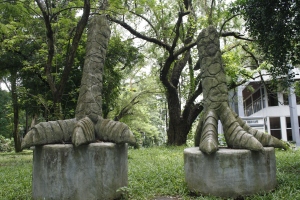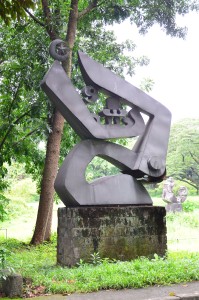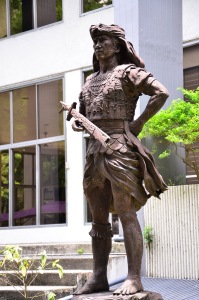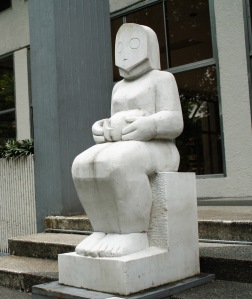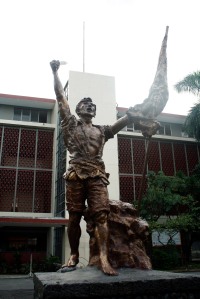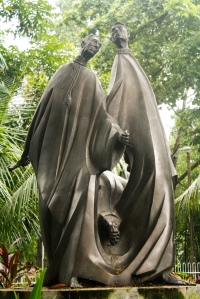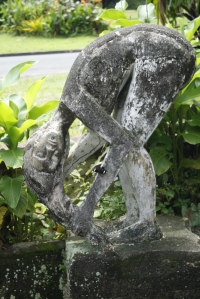In Artefact X, Cian Dayrit presents a narrative of mystification and demystification by fabricating a mock artifact which supposedly originated from an imaginary primeval civilization, and by specifically locating it within the Vargas Museum premises. Using context as an operative strategy, he tackles the problems in the customary practice of displaying archaeological objects. The piece portrays the fragmented ‘ruins’ of a bird figure, which is a recurrent element in mythology of different cultures. It is made of reinforced concrete and was finished in 2011.
Monthly Archives: February 2015
Untitled (Abdulmari Imao)
National Artist Abdulmari Imao’s untitled work is a large scale metal piece that is faithful to the calligraphic style and okir themes of Islamic art. It has been described as combining three interrelated themes, that of the sari-mosque as identified in the 5-pointed star that sits within the crescent moon, that of the sari-manok or the rooster with a fish caught in its beak, and that of the sari-okir with its curvilinear motif. This piece can be found near the entrance to the Jorge B. Vargas Museum.
Rajah Sulayman (Anastacio Caedo)
Anastacio Caedo portrayed Rajah Sulayman in a bronze statue finished in 1987. It was executed in a classical realist style, done in the tradition of his mentor, Guillermo Tolentino. In this piece, he depicted the historical ruler of Maynila brandishing a kris in a pose characterized by dignity and authority. Using the cire perdue or lost-wax technique allowed Caedo to create the intense facial expression and intricacy of the details in Rajah Sulayman’s clothes and armor. The technique involves the wax coating of a mould which would later be melted after it is covered with a perforated material, usually plaster or clay, thus the term lost-wax. The molten metal will then be poured into the space previously occupied by the wax.
Haliya the Moon Goddess (Duddley Diaz)
(formerly at the Vargas Museum)
Haliya was created in 1995 by Italy-based artist, Duddley Diaz. Using Carrara marble, a material abundant in the Tuscan Region of Italy, the figure is an austere image of Haliya, a mythical moon goddess believed by the Bicolanos to be the protector of women and the nemesis of Bakunawa, a gigantic serpent who swallows the moon, causing eclipses. Diaz finished a degree in Fine Arts in U.P., and also became an apprentice of Napoleon Abueva. He likewise pursued further studies at the Accademia di Belle Arti in Florence, Italy.
Ala-ala ng Bayang Filipino sa mga Bayani ng ’96 (Ramon Martinez)
Ala-ala ng Bayang Filipino sa mga Bayani ng ‘96 is a concrete polychromed statue done by Ramon Martinez between 1905 and 1911. It was inaugurated in Balintawak on 3 September 1911 but was relocated to the U.P. Vinzons Hall in 29 November 1968 to give way to the construction of the North Luzon Expressway. While often associated with Andres Bonifacio, it actually represents a nameless Katipunero. The statue is also popularly linked with the “Cry of Balintawak” because of its depiction of a katipunero’s battlecry. Aptly located outside Vinzons Hall, the campus student center, it is a constant reminder of the brand of activism and nationalism that U.P. stands for.
Gomburza (Tito Sta. Ana)
Gomburza is a bronze sculpture of three Filipino priests – Mariano Gomez, Jose Burgos, and Jacinto Zamora – martyred by the Spanish colonizers for their involvement in the Philippine Revolution. The artist, Tito Sta. Ana Sanchez learned the methods of molding pieces of metal into sculptural figures from his U.P. College of Fine Arts mentor, Anastacio Caedo. Found outside the Parish of the Holy Sacrifice, the artwork captured that moment just before their execution. Its bronze material emphasizes the flowing lines from the elongated figures and their flowing robes.
Bathing Female Nude (Ildefonso Marcelo)
The bathing female nude is uncharacteristic of Marcelo’s more recognized aesthetic. Done in concrete, it distinguishes itself from his other works. The angularity and massiveness found in Contemplation, Captivity and The Challenge is here replaced with gentle curves and a delicate form. It occupies a special place at the corner of the University Avenue and E. Jacinto Street as it forms part of a landscaped area complete with an ornamental pool and a small bridge.

